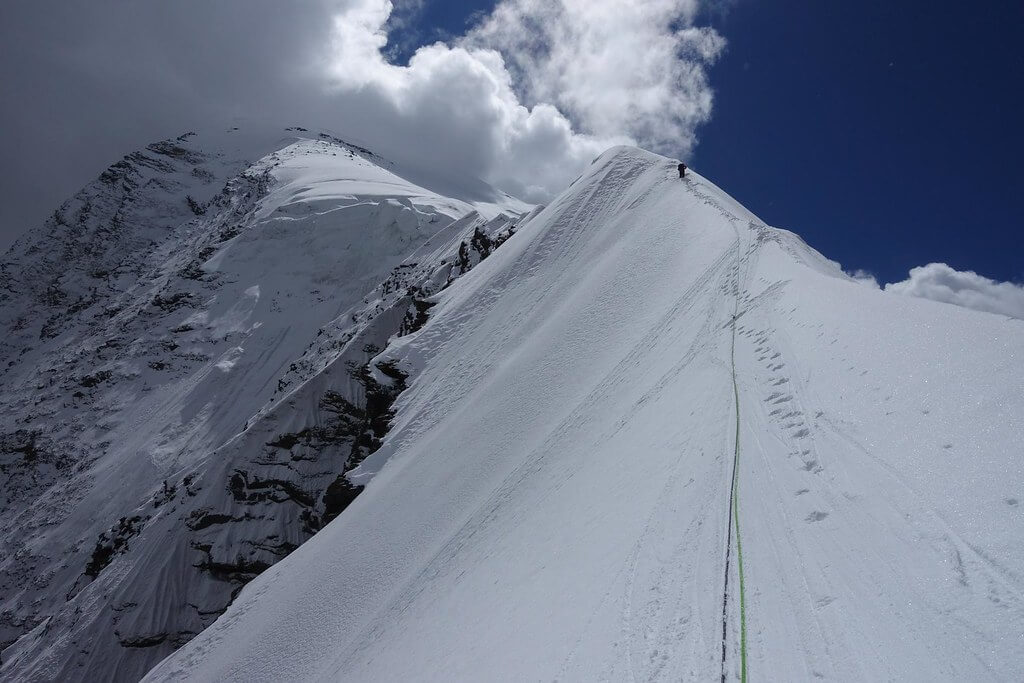Key Highlights
Altitude
7000M
Days
23D -22N
Exp. Leader
10+ Year
Ladakh
Group Size
5 - 10 Max
Transport
Leh
Overview
Mt. Nun Expedition
The second highest mountain of the Nun Kun range, Mt. Kun (7077M), is found in the upper Suru Valley. The twin peaks of Nun (7135M) and Kun (7135M) are separated by a 4km long snow plateau and are among the highest peaks in the Zanskar Range on the Indian side of the Line of Control. Along the Kashmir-Zanskar boundary, Mt. Nun and Kun, as well as Barmal, White Needle, and Pinnacle Peak, form a horseshoe above the Suru River. The trek to Mt. Kun is exclusively for experienced mountaineers who want to climb peaks that are 8000 metres or higher. It is necessary to have prior experience with technical and mountaineering skills such as the use of ice axes, rope up operations, crampons, and jumar climbing. This adventure helps you move from trekking peaks to climbing summits and acts as a preparation expedition for several 8000M+ peaks. The Mt. Kun expedition is ideal for mountaineers who have already summited summits of above 6500 metres.
Key Highlights
Altitude
7000M
Days
23D -22N
Ladakh
Group Size
5 - 10 Max
Exp. Leader
10+ Year
Transport
Leh
Complete
Itinerary of trek
Before beginning our Nun climb, we will travel to Stok Kangri Base Camp to help us acclimate to the high mountains of Ladakh. This is the day when we will have a fantastic drive and a memorable trekking adventure. This day will surprise you if you haven't walked in Laddakh previously. The breathtaking scenery of the region will transport you to another dimension. The granite mountain peaks all around seem flawless, as if they were painted on canvas. The day will be challenging, owing to the fact that it will be your first time walking in this area. The town of Stok is located south of Leh and is notable for its royal palace. A modest museum with elegant and holy relics is located within the palace. As soon as we get at Chang Ma, we will set up camp. After a short acclimatisation hike, we'll set up camp.
Guidelines
Things to carry
- Footwear: Trekking Boots (snow and water proof), normal walking boots, and floaters.
- Few pairs of warm/woolen socks.
- Luggage: Backpack (50 liters), Daypack (20-30 ltr), Duffel bag.
- Clothes: Waterproof breathable jacket & pants, Jacket (synthetic or fleece of down feather), insulated pants (Synthetic), Poncho, Sweatshirt, inner thermal (upper & lower), fleece, t-shirts, cotton trekking pants, shorts. * clothing as per the season
- Gear for Hand & Head: Liner glove, Bandanna, Sun hat, Woolen caps, Face mask etc. Accessories: Sunglasses/Goggles, anti-glare glasses, water bottle, hydra pack, Headlamp with spare bulb and extra batteries.
- Trekking Gears: Emergency tool kit.
- Protection and First-Aid: Sunscreen, toiletry kit, water purification tablets, Zip-lock bags, ear plugs, first-aid and all essential medicines.
- Camping Equipment: Sleeping bags (extreme -5 to +5 Celsius) with liner, trekking poles, etc.
- Shirts / T-shirts – 2/3, Warm shirt/light micro fleece pullover/full sleeve T shirt
- Trekking Pants that are water resistant/repellent and having inside lining for extra warmth- 2
- Windproof/water resistant outer shell (jacket) of good quality with a proper hood
- Down jacket with min 600 fill power rating, Thick Fleece / Full-sleeve Woollen sweater Thermal inner wear (upper and lower)
- Woollen cap, Inner fleece gloves, Outer water proof gloves
- Thick woollen socks and regular socks (4 – 5 pairs), Scarf/muffler (optional)
- Comfortable waterproof Trekking/Hiking shoes that come with a thick sole and high ankles
- Camp shoes such as sneakers/sport shoes
- Raincoat / Poncho
- Small light weight towel
- Insulated water bottle and hydration pack (optional)
- Cap / floppy hat to keep the strong sun away from your face, Sun glasses with UV protection and ability to cut the glare (important when traversing through snow) Sturdy walking stick / Trekking pole
- Sunscreen Lotion, Lip Balm
- Torch / Flashlight (with extra batteries)
- Medicines, if requiring any specific medication
- Personal toiletries
- Day pack/small bag which you will carry on your back every day and keep your essentials in it
- Carry rain cover for your bags
- Keep a few poly bags or waterproof bags in your bag in which if required you can put your belongings in case of heavy rain
Mandatory Personal Medical Kit
- Diamox – 10 tablets (to prevent AMS)
- Dexamethasone – one strip
- Nifedipine – 5 tablets
- Crocin – 6 tablets (fever)
- Avomine – 4 tablets (motion sickness)
- Avil 25mg – 4 tablets (allergies)
- Combiflam – 4 tablets (Pain killer)
- Norflox TZ & Lomofen– 6 tablets each (diarrhea)
- Digene – 10 tablets (acidity)
- Omez/ Rantadine – 10 tablets (antacids)
- Crepe bandage – 3 to 5 meters
- Gauze – 1 small roll
- Band aid – 10 strips
- Cotton – 1 small roll
- ORS – 10 packets
- Betadine or any antiseptic cream
- Moov spray (aches, & sprains)
- Knee cap, if you are prone to knee injury
- Anti fungal powder





